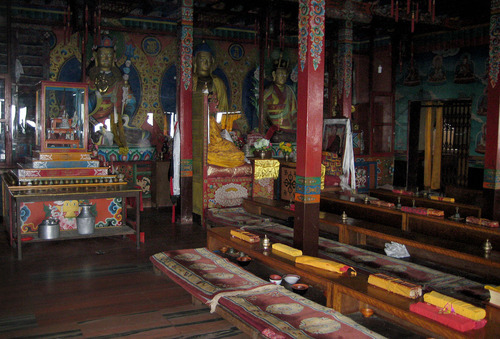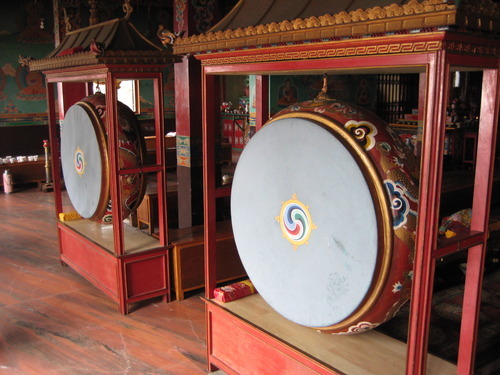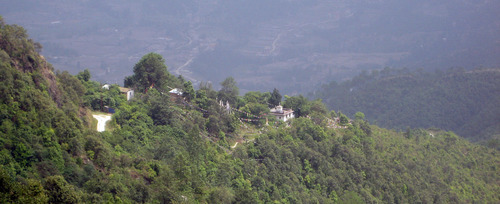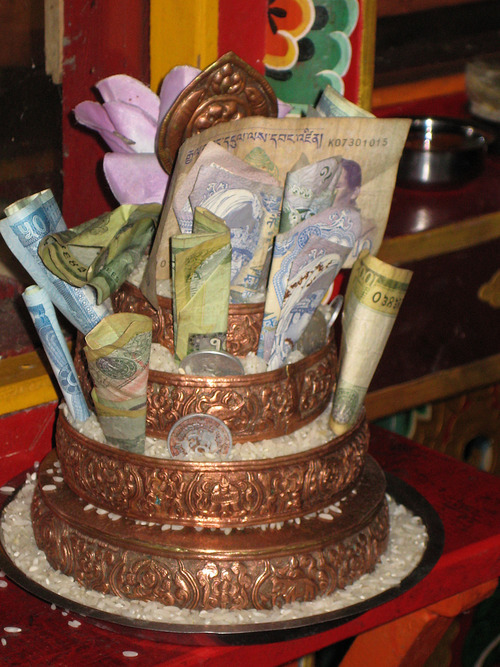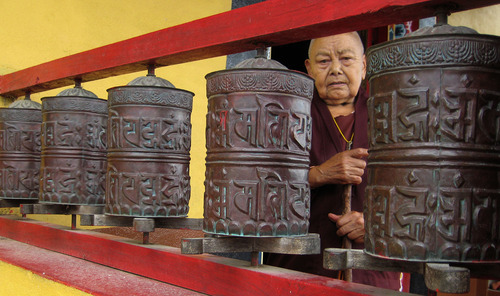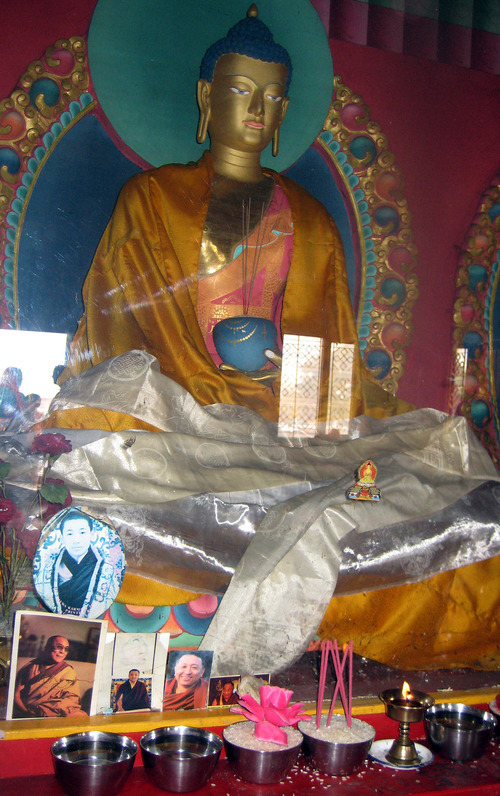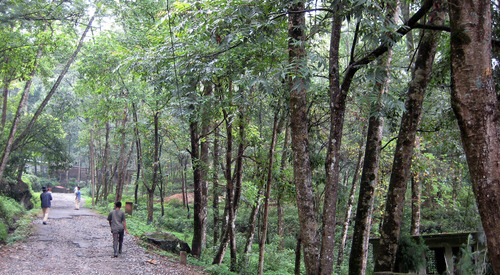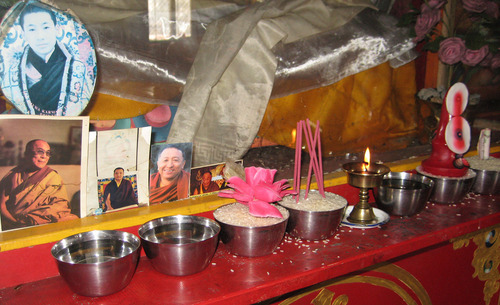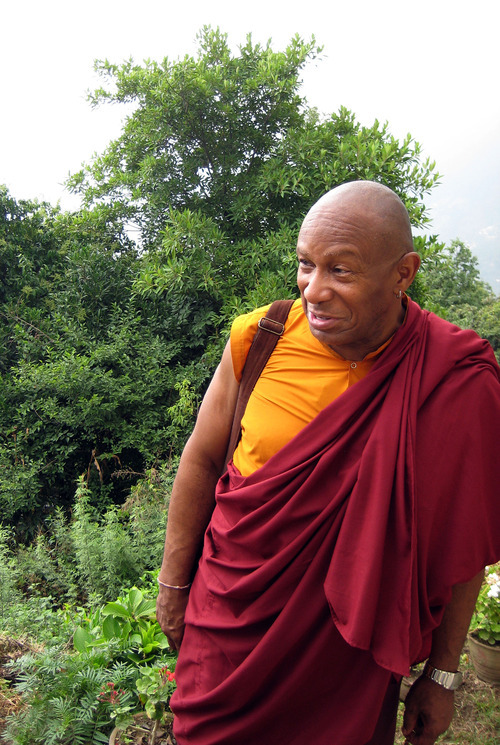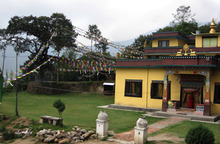This is an archived article that was published on sltrib.com in 2012, and information in the article may be outdated. It is provided only for personal research purposes and may not be reprinted.
Nagi Gompa, Nepal • His deeply wise, playful and luminous presence seemed to fill the tiny meditation space — even though Tibetan Buddhist master Tulku Urgyen Rinpoche had died 16 years before.
Disciples from Salt Lake City, most of whom the revered sage and mentor had never met, wedged shoulder to shoulder at the foot of his empty cushion, their gazes falling on flowers, vibrant flags and other ritual objects arranged much as he had left them.
The Americans grew silent for many minutes and sought to calm and clear their minds. A gentle monsoon rain dampened the lush green Nepali nature preserve outside.
"There is a very dynamic energy still in that room," said Lama Thupten Gyaltsen Dorje, the Salt Lake City-based Buddhist teacher who, along with his wife, Jean LaSarre Gardner, led a group of 18 Utahns to Nepal's capital of Kathmandu in June.
"It's all like a dream, sitting here now," he said in an interview back at the Urgyen Samten Ling temple in Salt Lake City.
The rare trip across 12 time zones brought Utah-based adherents of the orthodox Tibetan-influenced Nyingma tradition of Vajrayana Buddhism closer to the roots of their faith. The journey to the Himalayan nation also put the congregation members, or "sangha," in more immediate touch with treasured teachers in a lineage tracking back to the original Shakyamuni Buddha, who was born in Lumbini, Nepal.
In Buddhism, sacred teachings are passed from teacher to student. There is a sense of spiritual succession — lending potency to teachings transmitted along a direct line from original source to modern practitioner — that resonates with many Mormons and others who hold to similar lineage traditions.
Lama Thupten likened it to basking in powerful sunlight that has radiated through the centuries.
"The Buddha and the enlightened quality that is represented is unbroken," he said. "We can trace from our teacher to their teacher to the next, from generation to generation, from master to master, and we can see that there is a unity in that wisdom and knowledge that we ourselves can apprehend."
Lama Thupten, also known as Jerry Gardner, said he has returned to the pristine mountainside hermitage at Nagi Gompa repeatedly since he first met Tulku Urgyen Rinpoche in 1988.
"In a way," he said, "I'm always at Nagi.''
The sanctuary is home to a small temple, featuring large statues of the Buddha and other holy figures that were built by Tulku Urgyen Rinpoche, who spent 30 years there, two decades in retreat. Senior devotees describe the entire mountainside as Tulku Urgyen Rinpoche's "mandala" — referring to a system of intricate geometric patterns found in Buddhist art that also serves as a visual metaphor for profound spiritual symmetry.
"He was lighthearted and open like a beautiful flower,'' Lama Thupten said of his teacher, who died in 1996. "Rinpoche was light itself, and, in his presence, all of that which was dark within us ceased to be, fell apart.''
Even newcomers felt that aura.
"Although I'd never even seen pictures of Nagi Gompa before, there was a definite familiarity to it, as though I'd been there before," said Jared Kee, sangha member and graphic designer from Salt Lake City.
The Nagi Gompa tour was part of a tapestry of experiences for the Vajrayana Buddhists, who, along with Buddhists of other denominations, now number more than 8,600 in Utah, according to the latest census of faiths — making them the state's largest non-Christian religious group.
During the two-week visit, Urgyen Samten Ling members lived in spare monastic quarters at Ngoedrup Chareb Ling Retreat Center in west Kathmandu, guests of Khenpo Konchok Monlam Rinpoche, a venerated monk and teacher in Tibetan Buddhism.
Konchok Monlam became a teacher to Lama Thupten at Nagi Gompa at the request of Tulku Urgyen Rinpoche, prior to his death. Like Tulku Urgyen Rinpoche, Konchok Monlam fled his homeland of Tibet, the latter in 1958, in advance of a Chinese invasion.
Konchok Monlam has taught and received teachings at monasteries across India, Tibet and Nepal. Established 40 years later, his retreat center in Kathmandu is located a few blocks from Swayambhunath Stupa, a stunning mountain complex of shrines, monuments, statues and long circuits of prayer wheels considered among the most hallowed Buddhist sites in the Kathmandu Valley.
Now 73, Konchok Monlam guides nuns and monks in secluded retreats at the center, devoted to studying the Longchen Nyingthig lineage, a centuries-old cycle of Buddhist teachings known in English as the Heart Essence of the Great Expanse.
His title, "Khenpo," refers to his recognized status as a high-ranking teacher. In near-nightly instruction with his guests, Konchok Monlam, who has visited Utah, revealed a vast skill for illuminating Buddhist principles such as impermanence, compassion, merit and clarity of mind in concise and well-organized detail— all without reference to notes or texts.
"Being with him again,'' said sangha member Mark Earl of Salt Lake City, "was to be enveloped in the heart of practice.''
Visitors described Konchok Monlam as playful, humble, diligent, accomplished and dauntless. Though at times in ailing health, he often seemed to grow more energized as his prayer and teaching sessions stretched into the night.
The visit made him "very happy'' and held great spiritual meaning as well, according to Thupten Gelek Bumang, who is Konchok Monlam's translator and also oversees day-to-day management of the retreat.
In Vajrayana Buddhism, Gelek said, "the relation between Vajra master and student and between spiritual siblings — Vajra brothers and sisters — is considered immensely important on the path to enlightenment." Family relations are just for this life, he wrote from Kathmandu, "but with Vajra siblings, if we could keep the Samayas — or commitments — pure and unbroken, the relation is meant to continue 'til we all attain enlightenment as a group.''
The Utahns were enchanted with the center's nuns, several of whom recently emerged from three-year solitary retreats. "We get this idea in our head that monks and nuns are supposed to be regal and reserved," said Kee. But instead, he said, they were "funny, expressive and brimming with a lust for life and compassion'' while deeply devoted to Buddhism.
In daily prayer rituals that began at 5 a.m. with loud gongs to summon participants, the nuns shared their methods for reciting holy verses in chorus, from memory, and offered pointers on playing ceremonial horns, drums and cymbals. One evening's chanting of a familiar confession and fulfillment rite called Narak Kong Shak moved all participants indelibly, with nuns and their guests singing together "`with our hearts completely wide open,'' as one put it.
"The sounds seemed to resonate throughout my entire existence and, I bet, throughout Kathmandu," said Justin Martin, an information technology professional from Salt Lake City.
Near the trip's end, the group delivered clothing, hygiene supplies and toys to children at a small orphanage in Lalitpur, an outskirt of Kathmandu, run by Luke Hanley, a practitioner from Urgyen Samten Ling who lives in Nepal. Visiting the orphanage and conducting a blessing ceremony with Konchok Monlam brought a "great groundswell of joy,'' Earl said.
The pilgrims also toured sacred Buddhist sites. They meditated at Pharping, home to a small cave reputedly used by Guru Rinpoche, the exalted eighth-century sage credited with transmitting Vajrayana Buddhist to Tibet.
The sangha also visited Boudhanath Stupa, a large dome structure in northeast Kathmandu with honored relics and deep spiritual links to Tibetan Buddhism, one of the largest of its kind. As at Swayambhunath, visitors paid homage at Boudhanath with prostrations and by circumnavigating its perimeter clockwise in a ritual called "kora'' to accumulate blessings, spinning prayer wheels as they walked.
"What amazed me about Bouda was the sheer size and energy that it exuded,'' said Mark Yakovich of Midvale. "I was a Buddhist in a Buddhist land — finally."
Editor's note
Salt Lake Tribune reporter Tony Semerad participated in this Utah Buddhist pilgrimage to Nepal. —
About this series
P Saturday • Utahns trek to their faith's homeland
Sunday • USU climate study key to Nepal's future
Monday • Utahn helps Nepali clinic fight blindness


